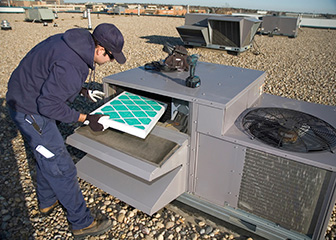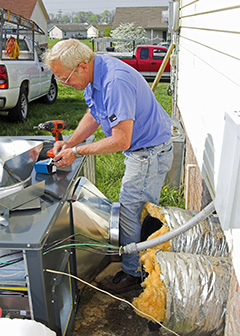How to Become a Heating, Air Conditioning, or Refrigeration Mechanic and Installer About this section

A technician inspects the filter on a roof top air conditioning unit.
Because HVACR systems are increasingly complex, employers generally prefer applicants with postsecondary education or those who have completed a formal apprenticeship. Some states and localities require technicians to be licensed.
Education
A growing number of HVACR technicians receive postsecondary instruction from technical and trade schools or community colleges that offer programs in heating, air conditioning, and refrigeration. These programs generally last 6 months to 2 years and lead to a certificate; or in some cases, an associate’s degree.
High school students interested in becoming HVACR technicians should take courses in shop, math, and physics. Some knowledge of plumbing or electrical work and a basic understanding of electronics can be helpful.
Training and certification
Some HVACR technicians learn their trade on the job, although this is becoming much less common. Informally trained technicians usually begin by assisting experienced technicians with basic tasks, such as insulating refrigerant lines or cleaning furnaces. In time, they move on to more difficult tasks, including cutting and soldering pipes or checking electrical circuits.
Some technicians receive their training through a formal apprenticeship. Applicants for apprenticeships must have a high school diploma or general equivalency degree (GED). Math and reading skills are essential.
Apprenticeship programs normally last 3 to 5 years, and combine paid on-the-job training with technical instruction. Over the course of the apprenticeship, technicians become familiar with subjects such as safety practices, blueprint reading, and how to use tools.
Apprenticeship programs frequently are run by joint committees representing local chapters of various organizations, including
- Air Conditioning Contractors of America
- Mechanical Contractors Association of America
- Plumbing-Heating-Cooling Contractors Association
- Sheet Metal Workers’ International Association
- Plumbing and Pipefitting Industry of the United States and Canada
- Associated Builders and Contractors
- National Association of Home Builders
Whether having learned the occupation through postsecondary education or through other means, HVACR technicians may take several different tests that measure their skills. These tests require different levels of experience. Technicians with relevant coursework and less than 2 years of experience may take the "entry-level" certification exams. These exams test basic competency in residential heating and cooling, light commercial heating and cooling, and commercial refrigeration. Technicians can take the exams at technical and trade schools.
HVACR technicians who have at least 1 year of installation experience and 2 years of maintenance and repair experience can take a number of specialized exams. These exams certify their competency in working with specific types of equipment, such as oil-burning furnaces or compressed-refrigerant cooling systems. Many organizations offer certifying exams. For example, the Air-Conditioning, Heating, and Refrigeration Institute offers the Industry Competency Exam. HVAC Excellence offers a Secondary Employment Ready Exam, a Secondary Heat exam, and a Heat Plus exam. The National Occupational Competency Testing Institute offers a secondary exam. The Refrigeration Service Engineers Society offers two levels of certification.
Certifications can be helpful because they show that the technician has specific competencies. Some employers actively seek out industry-certified HVACR technicians.
Licenses
Some states and localities require HVACR technicians to be licensed. Although specific licensure requirements vary, all candidates must pass an exam.
In addition, the U.S. Environmental Protection Agency (EPA) requires all technicians who buy or work with refrigerants to be certified in proper refrigerant handling. To become certified, technicians must pass a written exam specific to 1 of 3 specializations: Type I—servicing small appliances; Type II—high-pressure refrigerants; Type III—low-pressure refrigerants.
Many trade schools, unions, and employer associations offer training programs designed for the EPA exam.
Important Qualities
Customer-service skills. Technicians often work in customers’ homes or business offices, so it is crucial that they be friendly, polite, and punctual. HVACR repair technicians must sometimes deal with unhappy customers whose heating or air condition is not working.
Detail oriented. Technicians must be able to find problems and make precise repairs or adjustments. They must pay attention to details when installing or repairing equipment to make sure it works properly.
Dexterity. Technicians use many handtools and must have good hand-eye coordination to avoid injury.
Mechanical skills. HVACR technicians install and work on complicated climate-control systems. Workers must understand the components and be able to properly assemble and disassemble them.
Physical strength. Workers may have to lift and support heavy equipment and components, often without help.
Time-management skills. HVACR technicians often have a set number of daily maintenance calls. They should be able to keep a schedule and complete all necessary repairs or tasks.
Troubleshooting skills. Heating, air conditioning, and refrigeration systems involve many intricate parts. To repair malfunctioning systems, technicians must be able to identify problems, often with sophisticated diagnostic equipment.









